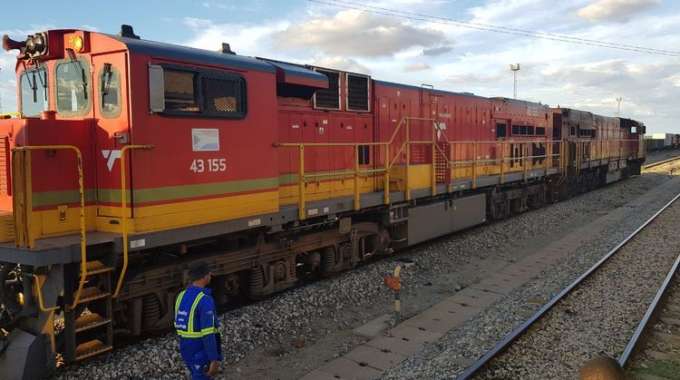
eBusiness Weekly

Here’s to asset awareness and financial innovation!
Chris Chenga
As details emerge about the NRZ, DIDG, and Transnet deal, it is stirring that NRZ been granted access to capital for what is really a free ride. Compliments must be made of DIDG’s financial, technical, and strategic shrewdness in how it has approached making the deal happen. The NRZ is getting a huge capital injection, at almost zero cost to the taxpayer — who through government is the agent stakeholder of NRZ.
In 2012, Transnet set out to pursue what it branded as a “Market Development Strategy”.
This initiative was backed by a $33,82 billion investment scheme, capacitating the company to invest in a cross regional ports and rail system. A few years later, the Government of Zimbabwe floated a tender for the capitalization of its underperforming, and grossly underutilized rail company, NRZ.
For DIDG, a group of highly skilled and experienced Zimbabweans based in South Africa, the aforementioned sequence of events was opportune. Indeed, it should be encouraged in our national discourse for business stakeholders to remain informed on global trends, especially for the purposes of transnational deal making.
Zimbabwe has numerous undervalued assets, and with asset awareness, deal makers can utilize this circumstance to leverage really great transactions with global partners.
There was no way Transnet was going to achieve its regional strategy while excluding the Zimbabwean rail network.
Zimbabwe connects SADC countries, who are largely raw material suppliers to at least three different ports in the south eastern corridor of the continent. Indeed this is why a $400 million deal should not have been a hard sell to an entity investing over $30 billion in regional connectivity. What this positioned DIDG to do is utilize a financial innovation called vendor financing.
Picking up on Transnet’s need for a functional Zimbabwean rail network, vendor financing could be used to capitalise NRZ at no cost to the taxpayer, but offer world class asset accumulation for NRZ.
Vendor financing is lending of capital by a vendor to its customers, who then use that capital to buy inventory or services from the vendor. In this instance, Transnet is the vendor, which through its joint venture with DIDG, is ultimately the financier of NRZ’s recapitalisation.
Transnet is using vendor financing to sell its stock to NRZ. Much concern has been raised about the quality of rolling stock to be acquired by the NRZ through this arrangement. As Transnet is supplying this stock, diligence into its capital expenditure history and its synergies with world leaders in rail would allay these fears. Transnet has spent over $4 billion in the last five years contracting the China Railway Construction Corporation (CRCC) to construct its locomotives. To date, CRCC is Transnet’s largest supplier of inventory, including locomotives, wagons, repair equipment, and communications hardware.
CRCC itself is the world leader in locomotive and wagon construction, both in terms of quality and efficiency, just ahead of Bombadier (Canadian) and General Electric (American) which rank second and third respectively.
Actually, Bombadier and GE in recent months have been considering joint ventures with CRCC. This should indicate the appreciated level of competence that CRCC has acclaimed from other leading entities in the rail sector. Caisse de Depot, a Canadian pension fund which invests on behalf of workers and retirees in the Canadian province of Quebec, owns the largest stake (30 percent) in Bombardier’s rail division.
Its CEO, Michael Sabia, has put forward a motion for Bombadier to partner with CRCC going ahead or the purposes of enhanced quality and efficiencies.
Thus, the locomotives and wagons constructed by CRCC are not only the industry benchmark, but a competitive advantage that other contending western manufacturers are being pushed by their shareholders to merge into.
All this should underline an understanding that the NRZ has been positioned to get supplies of top quality stock from CRCC, through the latter’s contracting under Transnet.
A vendor financing structure may also include a transfer of shares of the borrowing company to the vendor. The joint venture between DIDG and Transnet has claimed a 60 percent equity stake for as long as the tenure runs. This is normal business, and does not expose the interests of NRZ.
The less overt narrative about this deal is that there is no liability to the Zimbabwean taxpayer at all. All the risk resides in the joint venture of DIDG and Transnet. It is the business case advanced by Transnet’s Market Development Strategy that gives assurance to South African banks to avail funds for NRZ’s capitalisation.
Understandably, there is a lot of queries on whether or not this deal would result in trickle down benefits for a broad Zimbabwean workforce and citizenry.
Indeed there are many. At the higher level, Zimbabwe is being included into a regional network of rail, business that is of consistent cash flow, in global currencies.
For participants in agriculture, mining, and movement of goods, rail travel is cost effective. There will be a general reduction in cost of business, which will make multiple sectors more competitive within a regional context.
With such vibrant activity, there are wages to be made, and downstream spending into rentals, food and other consumptives.
The imperatives of this deal should not be understated. But perhaps what’s most impressive is the minimal cost that it came for. DIDG has shown a case study of the value for asset awareness and financial innovation.
For an environment with great reason to be cynical of national deals, even the most skeptical observer should commend how well executed this transaction has been.



